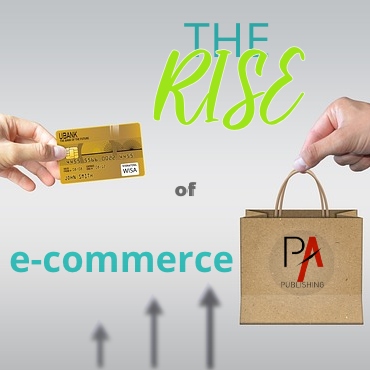The internet has transformed almost every aspect of our daily lives, and the way we shop for goods and services is no exception. With the rise of e-commerce, consumers can now shop from the comfort of their own homes and have their purchases delivered directly to their doorsteps. In this article, we’ll explore how e-commerce is revolutionizing the shopping experience, including its benefits and challenges, popular e-commerce platforms, and how it’s shaping the future of retail.
The Rise of Online Shopping
Benefits of E-commerce
One of the primary benefits of e-commerce is convenience. Consumers can shop online 24/7 from anywhere with an internet connection without having to leave their homes or brave crowds at physical stores. This allows consumers to save time and money on transportation, parking, and other expenses associated with traditional shopping. Additionally, online often offers a wider selection of products and easier comparison of prices and reviews.
Another advantage is personalization. Online retailers can use customer data to create personalized shopping experiences, recommend products, and offer targeted promotions, all of which can enhance customer satisfaction and generate incremental revenue for retailers.
Many benefits are for both the consumer and the seller.
E-commerce is the buying and selling of goods and services over the Internet. It has become increasingly popular in recent years as more people use the Internet to shop. There are many benefits, including:
- Convenience: E-commerce allows customers to shop from the comfort of their own homes, 24 hours a day, 7 days a week. They can browse a wide variety of products and compare prices from different retailers.
- Affordability: E-commerce can be more affordable than traditional retail, as there are no overhead costs associated with running a physical store. This means that businesses can pass on the savings to their customers.
- Global reach: E-commerce allows businesses to reach a global audience. This means that they can sell their products to people worldwide.
- Personalization: E-commerce platforms can collect customer browsing data and use this information to deliver personalized recommendations and offers. This can help businesses to increase sales and improve customer loyalty.
- Analytics: E-commerce platforms can track customer behavior, which can help businesses to improve their marketing campaigns and website design.
Overall, e-commerce offers a number of benefits for businesses and consumers. It is a convenient, affordable, and global way to shop. As the internet continues to grow in popularity, e-commerce is likely to become even more important in the future.
Challenges of E-commerce
However, e-commerce also brings challenges. One of the biggest hurdles is trust. Consumers may be reluctant to enter their sensitive information online or worry about getting scammed by fraudulent websites or products. Additionally, consumers may face uncertainty about the quality or fit of the products they buy without being able to touch or inspect them physically.
Another challenge is logistics. Online retailers must manage warehousing, inventory, and shipping to provide speedy and reliable delivery to customers. Shipping fees and times can make or break a purchase decision, especially for time-sensitive or bulky items.
This is a rapidly growing industry for sellers and buyers, but it also faces many challenges. Some of the most common challenges include:
- Security: E-commerce businesses need to take steps to protect their customers’ personal and financial information. This includes using secure payment processing systems and encrypting customer data.
- Fraud: E-commerce businesses are also at risk of fraud, such as credit card fraud and identity theft. They need to have measures in place to detect and prevent fraud.
- Customer service: E-commerce businesses need to provide excellent customer service. This includes responding to customer inquiries quickly and resolving problems promptly.
- Shipping: E-commerce businesses need to offer reliable and affordable shipping options. This is especially important for businesses that sell bulky or fragile products.
- International shipping: E-commerce businesses that sell products internationally need to be familiar with the regulations and customs of different countries. They also need to make sure that their shipping costs are competitive.
- Returns and refunds: E-commerce businesses need to have a clear and easy-to-understand returns and refunds policy. This will help to reduce customer dissatisfaction and improve customer loyalty.
Overall, e-commerce is a challenging but rewarding industry. Businesses that are able to overcome the challenges and provide a great customer experience will be well-positioned for success.
Here are some additional challenges of e-commerce:
- Competition: The e-commerce market is very competitive. Businesses must find ways to differentiate themselves from their competitors to succeed.
- Technology: The e-commerce industry is constantly changing. Businesses need to stay up-to-date on the latest trends and technologies in order to stay competitive.
- Regulation: The e-commerce industry is regulated by a variety of governments. Businesses need to be aware of the regulations that apply to them in order to avoid legal problems.
Despite the challenges, e-commerce is a growing industry with great potential. Businesses that are able to overcome the challenges and provide a great customer experience will be well-positioned for success.
Popular Selling Platforms
A variety of selling platforms are available for retailers to sell their products. Amazon is perhaps the industry’s most well-known and dominant player, accounting for a significant share of online sales in many product categories. Other popular buying and selling platforms include eBay, Walmart, AliExpress, and Etsy. Each platform has a different target audience, fees, shipping requirements, and other features, so it’s important for retailers to understand the pros and cons of each before deciding where to sell their products.
If you prefer to have your own website store, several popular e-commerce platforms are available, each with its own strengths and weaknesses. Some of the most popular platforms include:
- Shopify: Shopify is a cloud-based e-commerce platform known for its ease of use and scalability. It is a good choice for businesses of all sizes, and it offers a wide range of features, including a drag-and-drop website builder, a payment processor, and a shipping calculator. Shopify e-commerce platform
- WooCommerce: WooCommerce is a free e-commerce plugin that can be installed on WordPress websites. It is a popular choice for businesses using WordPress as their content management system. WooCommerce offers a wide range of features and extensions, and it is highly customizable. WooCommerce e-commerce platform
- Magento: Magento is an open-source e-commerce platform known for its flexibility and scalability. It is a good choice for businesses that need a high-powered e-commerce platform. However, Magento can be difficult to set up and maintain and is not as user-friendly as other platforms. Since Adobe acquired Magento, it has offered a cloud-based version identified as Adobe Commerce. Read more about the Magento e-commerce platform
- BigCommerce: BigCommerce is a cloud-based e-commerce platform that is known for its performance and security. It is a good choice for businesses that need a secure, high-performing e-commerce platform. BigCommerce is also relatively easy to use, even for beginners. BigCommerce e-commerce platform
- Wix: Wix is a website builder that also offers an e-commerce platform. It is a good choice for businesses creating a visually appealing online store. Wix is easy to use, even for beginners, and it offers a wide range of features. However, Wix can be expensive, and its e-commerce platform is less powerful than others. Wix e-commerce platform
The best e-commerce platform for your business will depend on your specific needs and requirements. However, the platforms listed above are all good options, and they offer a wide range of features and functionality.
Here are some additional factors to consider when choosing an e-commerce platform:
- Your budget: E-commerce platforms can range in price from free to hundreds of dollars per month. It is important to factor in your budget when making your decision.
- Your technical skills: Some e-commerce platforms are more difficult to set up and maintain than others. If you do not have a lot of technical skills, you may want to choose a platform that is easy to use.
- Your needs: What features are important to you? Do you need a scalable platform? Do you need a platform that offers a lot of customization options?
Once you have considered these factors, you can start to narrow down your choices and find the best e-commerce platform for your business.
Future of Retail
The future of retail is a hybrid of online and offline experiences. Consumers increasingly demand more convenience and personalization, and retailers are responding by investing in omnichannel strategies that allow them to meet these demands.
Here are some of the key trends that are shaping the future of retail:
- The rise of e-commerce: E-commerce sales are expected to reach $4.9 trillion in 2023, up from $3.5 trillion in 2020. This growth is driven by the increasing popularity of online shopping and the convenience and affordability of delivery services.
- The growth of omnichannel retailing: Omnichannel retailing is a retail strategy that combines online and offline channels to create a seamless shopping experience for customers. This includes features like click-and-collect, buy online, pick up in-store, and live chat with customer service representatives.
- The importance of personalization: Personalization is becoming increasingly important in retail as consumers demand more tailored experiences. Retailers are using data analytics to collect information about their customers’ preferences and then use this information to deliver personalized recommendations and offers.
- The rise of social commerce: Social commerce uses social media platforms to sell products and services. This trend is multiplying as more and more consumers use social media to research and purchase products.
- The adoption of new technologies: New technologies, such as augmented reality (AR) and virtual reality (VR), are starting to have a major impact on retail. These technologies can be used to create immersive shopping experiences that allow customers to interact with products more realistically.
The future of retail is still uncertain, but it is clear that the industry is undergoing a major transformation. Retailers that are able to adapt to these changes and embrace new technologies will be well-positioned for success in the years to come.
Here are some statistics that support the trends mentioned above:
- In 2023, e-commerce sales are expected to account for 17% of total retail sales.
- The average consumer now uses 5.4 different channels to shop.
- 70% of consumers say they are likelier to shop with a retailer offering personalized recommendations.
- Social commerce sales are expected to reach $292 billion by 2025.
- 73% of consumers say they are interested in using AR or VR to shop.
The future of retail is bright, but it will require retailers to be agile and adaptable. Those that are able to embrace new technologies and provide personalized experiences will be the ones that succeed.



